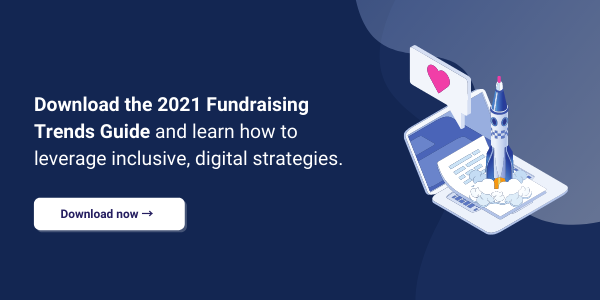As the year draws to an end, many will be more than happy to put 2020 behind us. This year, which we thought would usher in a new decade on a high note, instead took an enormous toll on our emotional states, our societal structures, and of course, our work in the charitable sector.
With Canadian nonprofits reporting a 30.6% decline in revenue since the onset of COVID-19, we’re looking at possible financial losses between $4.2 billion and $6.3 billion if we don’t adapt to these new times.
Keela and Imagine Canada have identified 5 emerging fundraising trends to help you pivot and set your organization up for success in 2021. Download the full guide here which includes tips, strategies, helpful checklists, and more.
1) Embracing New Technologies
Online fundraising is not a new concept. It continues to grow at a rate of 10% year-over-year, and as it gains more prominence among Canada’s charities and nonprofits, more innovative technology is springing up to keep pace.
Pre-COVID, email marketing was lauded as the ruler of nonprofit communications, but it’s not the only channel that yields effective returns. Mobile technologies, including mass communications and text-to-give initiatives, offer both large and small organizations an opportunity to forge relationships with their supporters without getting lost in their inboxes. And with a click-through rate of 4.2% on SMS fundraising messages compared to 0.56% with email, this is a great channel to explore further in 2021.
2) Reinventing Cultivation Using AI
Canadian organizations have laid off an estimated 37,000 full-time and 46,400 part-time paid staff in 2020. Besides the pain of losing team members, organizations are facing the added sting of needing to fulfill those roles with increasingly sparse resources.
So with less human power available, the natural progression is to turn to the artificial kind.
Before you go thinking Artificial Intelligence (AI) is too complex for you, remember you likely already use it (i.e. when you speak to Siri or when Netflix recommends media).
In nonprofit applications, AI streamlines tedious administrative work by sifting through contact and donation records. It can provide you with insight into your organization by finding patterns and trends which will help improve donor relationships, as well as help guide your decision-making, ensuring every cent has maximized returns.
The nonprofit sector needs to start embracing this type of technology. While 89% of nonprofits believe AI has the potential to make organizations faster, smarter, and more efficient, still just 23% utilize these types of solutions.
3) Understanding the Effects of Multiculturalism
With 1 in 5 Canadians born overseas, and over 320,000 newcomers arriving every year, the way forward is clear: it’s time to engage with all corners of Canada’s donor landscape.
As it currently stands, the giving opportunity represented by newcomers to Canada and second-generation Canadians could total approximately $1.7 billion. With the economic uncertainties brought about by COVID-19, this is a lifeline for the sector.
So how do you tap into this previously underrepresented donor pool? The journey begins inward. Diverse teams are proven to work smarter and produce better results than homogeneous teams.
And once your internal team better mirrors the diverse makeup of Canadian communities, read Imagine Canada’s report on the giving and volunteering behaviours of multicultural Canadians to use as a playbook for your charity, foundation, or nonprofit.
4) The Great Transfer of Wealth
The Great Transfer of Wealth will affect all branches of our economy, including the charitable sector. This term refers to the transfer of wealth from retiring Baby Boomers to Millennials over the next decade and beyond, and reflects an estimated $1 trillion in Canada alone.
As wealth changes hands, it’s expected the landscape of giving will fundamentally shift along with it. To stay abreast, it’s important to know who your donors are and how they operate online to make sure you have the tools to capitalize on their giving habits.
M+R Benchmarks notes that while the majority of giving occurs on desktop, an astounding number of donors are finding their inspiration after interacting with an organization’s ads on mobile. For example, while only 9% of donation page conversions happen on mobile (compared to 21% on desktop), 45% of those desktop conversions happened after people interacted with an organization’s ads on mobile. So, if your website isn’t mobile-friendly, you’re losing out on the younger generations’ donation dollars.
5) Trust and Accountability
2021 is primed to be a big year for organizational transparency and accountability. And rightly so.
Look at the recent WE Charity scandal, how the organization was lambasted in the media, and how that perception has filtered down to where 6 out of 10 Canadians feel there has been a major breach of trust.
To heal this wound, and to provide a failsafe against future criticism, charities and nonprofits should create processes rooted in transparency about their operations, activities, partnerships, and pay structures. This will help build trust with supporters, increase engagement, and lead to an average increase of 53% in donations (data shows that donors give more to transparent organizations.) So if your organization isn’t being transparent, you are giving others the opportunity to attract your potential donors.
Looking to develop more transparent standards at your organization? You can use Imagine Canada's Standards Program handbook as a framework to invest in trust in 2021.
----------------------------------------------------------------------------
One in four nonprofits are worried they won’t be able to keep their doors open past this year, making it a necessity to adapt, pivot, and re-energize. Rather than being reactive, this is a chance to stay ahead of the curve as we round out 2020.
The fundamentals are still the same. Relationships with supporters, donors, and other stakeholders are paramount to success, but the platforms in which we facilitate these relationships and the strategies for doing so are shifting.
Download our Guide to 2021 Fundraising Trends and lay the groundwork for inclusive, digital strategies that will carry your organization into the future.
Guest contributions represent the personal opinions and insights of the authors and may not reflect the views or opinions of Imagine Canada.
A storyteller by nature and an organizer by inheritance, Sam enjoys crafting meaningful content equally as much as colour coding spreadsheets. As the Marketing Director at Keela, a Canadian Donor Management Software (CRM), she is always on the hunt for new and innovative ways to educate nonprofits and help them maximize their impact.





